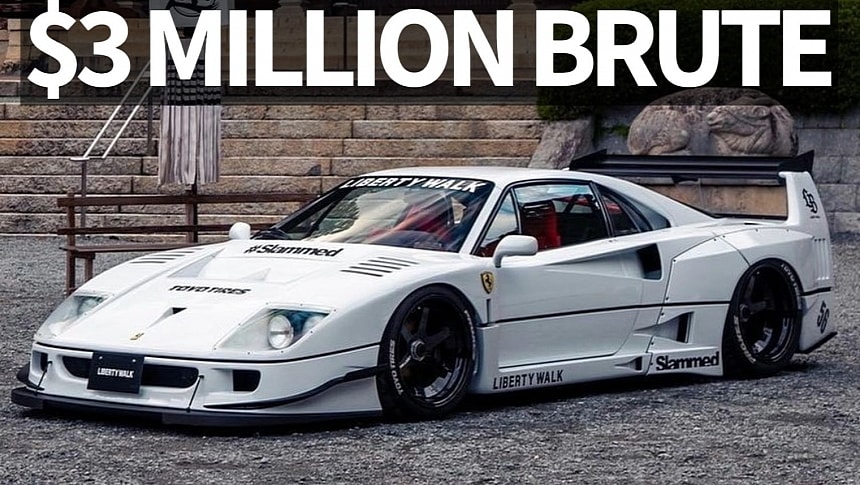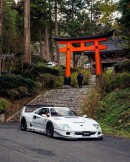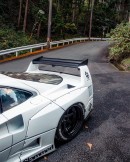Since it is considered one of the best Ferraris ever made, next to the iconic 288 GTO and its successors, the F50, Enzo, and LaFerrari, the F40 should be kept in stock condition. Purists would never approve of the slightest modification, and we kind of agree with them.
However, we cannot ignore the coolness of a Liberty Walk-tuned Ferrari F40, which boasts the usual upgrades the tuner based in the Land of the Rising Sun is famously known for.
We dedicated a couple of stories to this particular ride in recent times, so if you feel like you've seen it before, now you know where. But why write another piece about it? Because it became the focus of the camera lens again, with images of it being shared on social media by Liberty Walk's founder.
Just like before, this white-finished Ferrari F40 stands out due to a few reasons, and they're all tied to the aforementioned tuner. These include those front and rear fender attachments with a visible bolt design, which make the entire car much wider than stock, a set of side skirts, and the usual add-ons at both ends, including a large diffuser, a Liberty Walk-branded wing, etc.
Several decals decorate the classic supercar's body, and the tuner's name is visible on the front windscreen. The five-spoke alloys were added as part of the aftermarket makeover. They have wide lips and a dark finish, which contrasts the rest of the exterior, and were shod in Toyo tires that sport white branding for a racier vibe. This F40 also has an adjustable air suspension, hence the low-rider stance.
Other modifications include the vented hood, a new exhaust system with three tailpipes that have a larger diameter than the stock ones, and a few other bits and bobs. Liberty Walk does not modify the engines of its projects, so the factory-fitted V8 still supplies the firepower. It is a twin-turbocharged lump with a 2.9-liter displacement, which was good for 471 horsepower (478 ps/352 kW) and 426 pound-foot (577 Nm) of torque when it rolled off the line.
Some may argue that the output and thrust are not impressive, but keep in mind that the Ferrari F40 was developed in the '80s and assembled from 1987 to 1992. Thus, it was a true beast back then, and it is still impressive by modern standards, with 0-62 mph (0 to 100 kph) taking 4.1 seconds. Flat-out, it can still outrun some modern blue-blooded rides, as it has a maximum speed of 201 miles an hour (324 kph).
A greatly-preserved Ferrari F40 will set you back around $3 million, so if you owned one, would you have given it an aftermarket touch? We won't judge you if you say yes. After all, we only live once, right?
We dedicated a couple of stories to this particular ride in recent times, so if you feel like you've seen it before, now you know where. But why write another piece about it? Because it became the focus of the camera lens again, with images of it being shared on social media by Liberty Walk's founder.
Just like before, this white-finished Ferrari F40 stands out due to a few reasons, and they're all tied to the aforementioned tuner. These include those front and rear fender attachments with a visible bolt design, which make the entire car much wider than stock, a set of side skirts, and the usual add-ons at both ends, including a large diffuser, a Liberty Walk-branded wing, etc.
Other modifications include the vented hood, a new exhaust system with three tailpipes that have a larger diameter than the stock ones, and a few other bits and bobs. Liberty Walk does not modify the engines of its projects, so the factory-fitted V8 still supplies the firepower. It is a twin-turbocharged lump with a 2.9-liter displacement, which was good for 471 horsepower (478 ps/352 kW) and 426 pound-foot (577 Nm) of torque when it rolled off the line.
Some may argue that the output and thrust are not impressive, but keep in mind that the Ferrari F40 was developed in the '80s and assembled from 1987 to 1992. Thus, it was a true beast back then, and it is still impressive by modern standards, with 0-62 mph (0 to 100 kph) taking 4.1 seconds. Flat-out, it can still outrun some modern blue-blooded rides, as it has a maximum speed of 201 miles an hour (324 kph).
A greatly-preserved Ferrari F40 will set you back around $3 million, so if you owned one, would you have given it an aftermarket touch? We won't judge you if you say yes. After all, we only live once, right?








